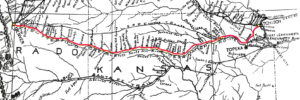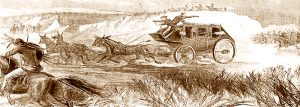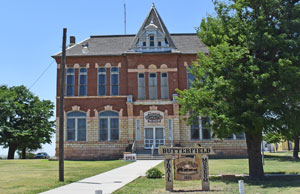The Smoky Hill Trail was established in 1859 to cross the Great Plains to Colorado during the Pike’s Peak Gold Rush. The trail ran from Atchison, Kansas, on the Missouri River to Denver, Colorado. For most of the way, it followed the Smoky Hill River.
The first Butterfield Overland Despatch stagecoach left Atchison, Kansas, on Monday, September 11, 1865, and arrived in Denver on Monday, September 23, 1865. The trail covered 592 miles.
Along the many stage routes, stations were established about every 12 miles that included two types — “swing” and “home.” As the stage driver neared the station, they would blow a small brass bugle or trumpet to alert the station staff of the impending arrival.
The larger stations, called “Home Stations,” generally run by a couple or family, were usually about 50 miles apart and provided passengers with meager meals and overnight lodging. However, “lodging” was often no more than a dirt floor. These stations also included stables where the horses could be changed, a blacksmith and repair shop, and a telegraph station. Here, drivers were usually switched.
The more numerous “swing” stations, generally run by a few bachelor stock tenders, were smaller and usually consisted of little more than a small cabin and a barn or corral. Here, the coach would stop only about ten minutes to change the team and allow passengers to stretch before the coach was on their way again.
The trail and stations constantly changed; therefore, the places and miles listed below are not exact.
Butterfield Overland Despatch Stations and Stops – 1859-1870
| Station | County | Miles From Atchison | Miles From Last Station |
More Information |
| Mount Pleasant | Atchison | 8 | 8 | |
| Fort Leavenworth | Leavenworth | Fort Leavenworth, Kansas, was established by Henry Leavenworth on the Missouri River on May 8, 1827. It was the first settlement in Kansas territory and is the oldest active Army post west of the Mississippi River. | ||
| Easton | Leavenworth | Easton, Kansas, an important early settlement of Leavenworth County, was founded in the Fall of 1854. | ||
| Hickory Point | Jefferson | Hickory Point, Kansas, began when Charles Hardt settled in Jefferson Township and started a trading ranch in June 1854. | ||
| Ozawkie | Jefferson | |||
| Silver Lake | Shawnee | |||
| St. Mary’s | Pottawatomie | |||
| Louisville | Pottawatomie | 10 | Described as having good water and grass. | |
| Juniata Crossing | Pottawatomie | Juniata CrosDyer’sor Dyer’s Crossing, was on the east side of the Blue River, north of present-day Manhattan. The first settlement in the county was at the crossing of the Fort Leavenworth-Fort Riley Military Road. | ||
| Fort Riley | Riley | 116 | 15 | Described as having water, wood, and grass. |
| Junction City | Geary | 119 | 3 | Home station. |
| Chapman Creek | Dickinson | 131 | 12 | This station was on the military route connecting Fort Riley with the Santa Fe Trail south of Ellsworth. Today, a Smoky Hill Trail & Butterfield Overland Despatch Segment remains in the area and is listed on the National Register of Historic Places. It is adjacent to Indian Hill Cemetery on the west side of Chapman in Dickinson County. It can be seen at 522 Golf Course Road in Chapman, Kansas. |
| Abilene | Dickinson | 143 | 12 | Home station. |
| Solomon River Crossing | Saline | 153 | 10 | |
| Salina | Saline | 166 | 13 | Home station. This was the end of the track in April 1867. |
| Spring Creek | Ellsworth | 181 | 15 | This relay station was located about 1.5 miles west of the old townsite of Terra Cotta. There are no remains today. The station site was located ½ mile west and ½ mile south of the Junction of K-140 & K-141 Highways. |
| Fort Ellsworth (later Fort Harker) | Ellsworth | 195 | 14 | Home station. Fort Ellsworth was located where the military road crossed the Smoky Hill River. It was located on the north bank of the river. |
| Buffalo Creek | Ellsworth | 205 | 12 | Swing station where the team was changed. |
| [sta_an “hor id=”hicks”ta Hick’s/]Hick’s/Lost Creek Station | Russell | 214 | 15 | A home station where passengers could get a meal. First called Lost Creek, then Wilson Creek, before chanHick’so Hick’s Station. The trail turned almost due west, keeping to the level benchland north of the Smoky Hill River. |
| Bunker Hill | Russell | 222 | 8 | |
| Fossil Creek | Russell | 230 | 15 | From here, the trail swung a little to the northwest, leaving the river banks. Fossil Creek was at the future site of Russell, Forsythe’s |
| rsythe’s Creek | Russell | 240 | 11 | Also called Walker Creek, the station was abandoned in favor of Fort Fletcher about five miles west. It was burned down by Indians in 1867. |
| Hays Creek | Ellis | 256 | 15 | This was the end of the track in the fall of 1867. |
| Fort Fletcher | Ellis | 5 | A home station with military protection. It was also called Forks of Big Creek. It was located four miles west of Victoria, Kansas. The main building stood on the south bank of Big Creek. It was renamed Fort Hays. | |
| Big Creek | Ellis | 11 | Home station. The stables and pasture were on the north side of the creek. This station also had a blacksmith shop, and 8 to 12 people worked there. Stage drivers changed here. | |
| Lookout Station | Ellis | 261 | 9 | This was one of the few stations where no tunnels joined the main station house with the stables. The station was attacked in April 1867 by Sioux and Cheyenne, who burned the building, stole its stock, and nailed the cook to the barn before burning it. The station was rebuilt in 1868. Though the buildings are long gone, a Butterfield Overland Dispatch marker designates the site. It was five miles south and three miles west of Hays, Kansas. |
| Louisa Springs | Ellis | 12 | This station was named for Lieutenant JuFitch’s Fitch’s wife, who accompanied her husband on his survey of the trail in 1865. It was abandoned in favor of Stormy Hollow 5-6 miles west. | |
| Bluffton | Trego | 14 | It was also known as Threshing Machine Canyon, south of WaKeeney, Kansas. It was abandoned in favor of White Rock Canyon due to Indian raids. White Rock was about three miles further west. | |
| Stormy Hollow | Trego | 273 | It was located on the eastern edge of Trego County. It was burned down by Indians in 1867. | |
| White Rock | Trego | 284 | White Rock Station took the place of the abandoned Bluffton Station. It was only about three miles northwest of Bluffton. It was burned down by Indians in 1867. | |
| Downer | Trego | 294 | 13 | Home station. It was also kDowner’sDowner’s Creek and Fort Downer. It was made a home station because of the delicate grass and water. However, it was situated well for defense and suffered from Indian attacks before it was abandoned on May 28, 1868. It was located 12 miles south and five miles west of Wakeeney, Kansas, or three miles south of Bosna, Kansas, on the west side of the creek. It was burned down by Indians in 1867. |
| Ruthton | Trego | 7 | This station was only used for a short time. It was probably named for West’sn West’s wife, who was along on the 1865 survey. | |
| Castle Rock | Trego | 305 | 9 | This station was located on the western edge of Trego County. From here, the trail veered to the southwest. It was burned down by Indians in 1867. |
| Grannell Springs | Gove | 313 | 11 | |
| Chalk Bluff | Gove | 316 | 12 | Situated on the north banks of the Smoky Hill River. It was burned down by Indians in 1867. The station was located south of Gove, Kansas, near the K-23 highway. |
| Carlyle | Gove | 7 | This station was also known as Bridgins Raisin and Carlysle Hall. It was burned down by Indians in 1867. | |
| Monument | Gove | 344 | 13 | A home station, it was also known as Monument Rock and Antelope Station. The station was built very much like the others. However, the stable was a long dugout gouged into the north bank of the river, where it was well protected. It was located near the western boundary of Gove County. One mile northeast of the station was Monument Rocks. |
| Smoky Hill | Logan | 356 | 11 | Also known as Smoky Hill Spring Station and Four Crossing Stage Station. |
| Eaton | Logan | 366 | 12 | A home station, this place was also known as Russell Springs, Wood Bottom, and Death Hollow. It was named for Colonel Eaton, who headed the construction crew of 26 men who built the stations along the trail. Just a few miles west of Eaton Station, where the river forked, there was a favorite campground called the Forks of the Smoky. After several Indian raids, the place earned the name Death Hollow. |
| Death Hollow Campground | Logan | This was not a station but a favorite campground just a few miles west of Eaton Station. Here, the river forked, also called the Forks of the Smoky. After several Indian raids, the place earned the name Death Hollow. | ||
| Henshaw Springs | Logan | 380 | 13 | Also known as Henshaw Creek Station and Bluff Camp, this site was located on the north bank of the South Fork of the Smoky Hill River. It began as a military post founded about 1865, shortly after the Civil War. It was not the best place for a small command post because of the frequent Indian attacks in the area. The first recorded attack was on June 5, 1867, when the Indians killed four men and stampeded the horses. At the time, the station was guarded by only ten soldiers and two stock traders, so pursuing the Indians was out of the question. When a force arrived from Fort Wallace, the Indians had dispersed. It was located near McAllaster, about nine miles east of Fort Wallace. |
| Fort Wallace – Pond Creek | Wallace | 391 | 11 | A home station, this place was also known as Duck Pond. The original station was two miles west of Fort Wallace. Like most stations, this one had underground tunnels running from the house to the barn and from both buildings to the rifle pits. The rifle pits were big enough for two men to stand in and were covered with a large slab of stone held off the ground with short pieces of wood. There were three of these pits: one at the end of the tunnel running out from the stable, one going from the house, and one larger than the others that guarded the rear of the station. |
| Goose Creek | Wallace | 402 | The establishment of this station divided the relatively long distance between Pond Creek and Willow Creek and offered more protection. However, the soil here was very sandy, and floods were a constant threat. | |
| Willow Creek | Wallace | 14Fitch’s | alled Fitch’s Meadow, for Lieutenant Fitch, who led the surveyors. The grass was good, and the Indians fought to keep possession of it, so Willo Creek and Goose Creek stations had trouble with the Indians. | |
| Blue Mound | Wallace | 412 | 9 | Also known as Big Timbers, Big Grove, and Big Cottonwood Grove |
| Cheyenne Wells, Colorado | Cheyenne | 13 | This place was a home station five miles north of the town of Cheyenne Wells, on the south bank of Smoky Hill River. In 1Fitch’seutenant Fitch’s survey party dug the well just north of the south fork of the Sm”ky Hill River.
“We found a large and handsome frame stable for the mules but no dwelling. The people lived in a natural cave, extending for some thirty feet u”der the bluff.” — Bayard Taylor, a famed adventurer and writer |
|
| Eureka Station | Cheyenne | 11 | This station was located 11 miles southwest of Cheyenne Wells. | |
| Duboise | Cheyenne | 24 | This place was a home station six miles southeast of Kit Carson. At this point travelers Bent’sg toward Bent’s Fort on the Arkansas River left the SmoGrady’s Trail. | |
| Grady’Grady’s | nne | 11 | Grady’s Station was located on the north bank of Big Sandy Creek, one mile west “f WGrandy’se.
“At Grandy’s Station, there was but one man, a lonely troglodyte, burrowing in the bank like ” cliff swallow.” |
|
| Connell Creek | Lincoln | 13 | A home station, this place was also known as Cornell Creek or Cornett Creek. It was located at the point where Connell Creek ran into Big Sandy Creek. | |
| Coon Creek | Lincoln | 12 | This place was located on the north bank of Coon Creek at its junction with Big Sandy Creek. | |
| Hogan | Lincoln | 11 | This location had a spring called Camp Barron on the north bank of Big Sandy Creek. The station was located nearHedinger’sorado. | |
| Hedinger’s Lake | Lincoln | 9 | Also known as Lake Station, it was located at the junction of Lake Creek and Big Sandy Creek. Here, the North and South trails separated in 1866. The station was a huge dugout with sod walls above the ground. It was large enough to hold an entire stagecoach. There was also a tunnel connecting the station to Mule Cellar. It was an important stage station before Limon came into existence. When the railroad came through, this was the end of the railroad and the starting point of the stage road to Denver. It was three miles east and a little south of Limon, Colorado. | |
| Big Bend of Sandy | 13 | It was located on the Well’s Ranch two miles northwest of present-day River Bend. Here, the Smoky Hill Trail crossed Big Sandy Creek for Reed’scond time. | ||
| Reed’s Spring | Elbert | 13 | This place was a home station with a huge dugout that could hold a stagecoach and team without unhitching it. It was also used as a store. It was on Reed’sst bank of Reed’s Creek, a tributary to the East Bijou. From here, a branch road went to Colorado Springs via the Bijou Basin and Eastonville. Three miles west of the station, the Smoky crossed East Bijou Creek. | |
| Bijou Creek | Elbert | 12 | The station was on Station Gulch, about a mile east of West Bijou Creek. | |
| Kiowa Creek | Elbert | 9 | Kiowa Station was in the town of Kiowa. A branch trail, which followed Kiowa Creek, connected the Butterfield, or Smoky Hill South, with the Starvation Trail, where the latter crossed Kiowa Creek. | |
| Ruthton/Running Creek | Elbert | 9 | A home station, its name was changed to Ruthton Station after the station in Kansas was abandoned. This station was near Osborn, formerly a post office. The station was on the west side of Running Creek, just above its junction with Henderson Gulch. The Smoky Hill Trail, which passed north of Elizabeth, followed up Henderson Gulch and passed a mile north of Round Hill, now Hilltop, to Parker on Sulphur Gulch, near its junction with Cherry Creek. | |
| Sulphur Gulch | Douglas | Also known as Parkhurst Station, it was located on the south bank of Sulphur Gulch and had a good well. The stop later moved to Twenty Mile House. | ||
| Twenty Mile House | Douglas | This place was a short distance from Sulphur Station and may have held most of the facilities of the Sulphur Station. It was a mile or two southeast of Parker. Twenty Mile House was a two-story building. | ||
| Cherry Creek | Denver | 16 | Also called Cherry Valley Station, it was located at the junction of Sampson Gulch and Cherry Creek. This was the point where the Starvation Trail or Middle Smoky Hill Trail reached Cherry Creek. It had good wood, water, grass, and wild game. | |
| Denver | Denver | 593 | 14 | This home station was the end of the trail marked at the junction of three corners of Broadway, Colfax, and Fifteenth Streets in Denver, Colorado. |
©Kathy Alexander/Legends of America, updated November 2023.
Also See:
Stagecoaches of the American West
Sources:
Colorado Magazine, State Historical Society of Colorado, March 1934
Lee, Wayne C. and Raynesford, Howard; Trails of the Smoky Hill, Caxton Press, 1980
The Raynesford Papers
Santa Fe Trail Research (website no longer active)
Smoky Hill Trail Association



